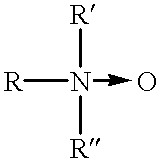Reduced residue hard surface cleaner
a technology of hard surface cleaner and cleaner, which is applied in the direction of detergent compounding agent, liquid soap, non-ionic surface active compound, etc., can solve the problems of difficult cleaning of hard, glossy surfaces such as glass windows, and the ability of ammonia-based cleaners to remove soil fairly well, and achieves the effect of reducing the amount of residue on such hard, glossy surfaces
- Summary
- Abstract
- Description
- Claims
- Application Information
AI Technical Summary
Benefits of technology
Problems solved by technology
Method used
Image
Examples
example 1
In Table I below, base formulations "A," "B," "C" and "D" are set forth. Unless otherwise stated, percentages are given as 100% active, and in percent by weight. Each of these formulations contains the preferred diphenyl oxide disulfonate surfactant.
In the next set of examples, the Formulations A, B, C and D were used, but A was varied as to diphenyl oxide disulfonate content. Thus, for the sake of clarity in this test, in addition to the alkyl pyrrolidone and the alkyl sulfate, the following surfactants were present in the following amounts in A, B, C and D:
The cleaners of Examples A through D were then tested for foaming (upon application and during removal) and streaking / filming performances, by a pair of expert panelists. The foaming test was conducted on a 1 to 5 visual grading scale, with 5 meaning no foam. The visual grade was based on a 1 to 10 scale, with 10 being no streaking. The surface tested was a mirror tile, to which 2-3 sprays of a trigger sprayer containing the inv...
PUM
| Property | Measurement | Unit |
|---|---|---|
| vapor pressure | aaaaa | aaaaa |
| Vapor pressure | aaaaa | aaaaa |
| semi-polar | aaaaa | aaaaa |
Abstract
Description
Claims
Application Information
 Login to View More
Login to View More - R&D
- Intellectual Property
- Life Sciences
- Materials
- Tech Scout
- Unparalleled Data Quality
- Higher Quality Content
- 60% Fewer Hallucinations
Browse by: Latest US Patents, China's latest patents, Technical Efficacy Thesaurus, Application Domain, Technology Topic, Popular Technical Reports.
© 2025 PatSnap. All rights reserved.Legal|Privacy policy|Modern Slavery Act Transparency Statement|Sitemap|About US| Contact US: help@patsnap.com



